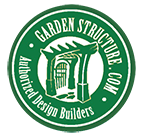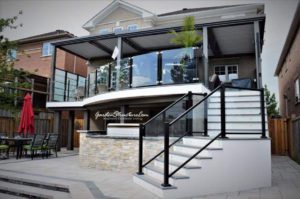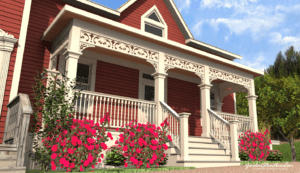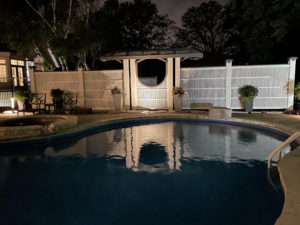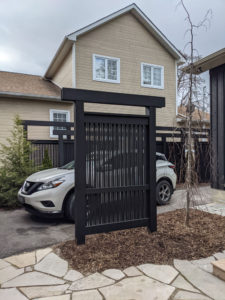Sustainable Decks — Inspected after 15 Years

Truly sustainable decks don’t get transported thousands of miles on a truck. Locally sourced timber from a local mill of a species that doesn’t need pressure-treating to last decades.

There is a local species in every area that lasts longer than you might expect. A local lumber mill can tell you which ones are available, and what to expect for durability.
In the Great Lakes area, there is Hemlock, Tamarack, White Cedar, and White Oak and Pine. Most of the barns were clad in Hemlock over the past 200 years, and some are still standing today. If using Pine or White Cedar it won’t last as long, so, use rough-cut lumber to extend the durability. Sealing the ends and staining the back surface may help it last longer. You can use a floor sander to make the decking smooth after you install it.
In the Southern States, Swamp Cypress is king! On the West Coast, you have Red Cedar and Redwood.
The East Coast has White Cedar and Pine.

A 15-Year-Old Sustainable Deck – Made of Hemlock in Ontario
This Hemlock deck was made of rough-cut 2×8 decking boards on rough-cut 2×8 joists. At the time of photography, it was 15 years old. It was not dried and was put down green. It was nailed–and no, no nail pops are evident. It is as tight as a drum and shows no signs of rot. The materials were a fraction of a typical cedar deck
The price of this deck was about 30% less than a typical red cedar deck. These days, materials cost roughly 50% for wood decks, and nearly 65% materials for PVC decks.
If your average wood deck is 20k, you would be roughly 14k for the same deck in Hemlock or Pine.

If you have ever heard of Millboard, this decking looks quite similar up close at 15 years old. Millboard is the most beautiful and expensive deck you can buy here in Canada. Rustic is not for everyone…. but, as a deck builder who has built furniture-grade decks for 30 years, I truly like the look.
If it doesn’t last- It’s not Sustainable!
Sustainable decks have to outlast the average. Filling the local landfill with half-rotted timber every 10 years makes no sense. Factor in the chemicals used in pressure-treated lumber also going to the dump every 5 or 10 years, it’s a toxic waste! That’s not efficient. Building a deck that lasts decades makes more sense. That’s the reason we don’t build many budget decks. A small investment can double the return on your investment.
We didn’t know that hemlock decks would last so long when we built the first one. The local lumberman told us it would last, so, we tried it. Based on how it has lasted so far, this deck will have a lifetime or 30 years or more.
The average pressure-treated frame clad with composite will last 15 years. The average staircase by budget builders will last about 5 or 10 years.
By sealing end grains, using joist and beam tape, and building in ventilation we can extend that life to nearly 50 years. What do you think is more sustainable? Building a deck once, or 3x in 50 years?

Red Cedar decks with a sealed frame and aluminum railings can last 20 years or more. If you build the frame to prevent rot and use Aluminum railings, just the decking can be changed extending most of the deck’s useful lifetime to 50 years. This also makes sense from an environmental standpoint.
Wooden rails do tend to rot due to trapped moisture.
So, what does the Building Department Think?
Here’s the bad news.
The building departments here in Ontario do not understand anything about long-lasting local timber, or, using rough-cut lumber without pressure treating for frames. There are many things they know little about… but, Alas, they will fight you.
They will insist that the lumber is inspected and stamped, “Graded”. The local mill can likely help you with that.
Alternatively, any local structural engineer versed in rough-cut lumber will likely stamp your plans which trumps the local building department. As long as your deck meets zoning requirements and basic code requirements, you should be good.
